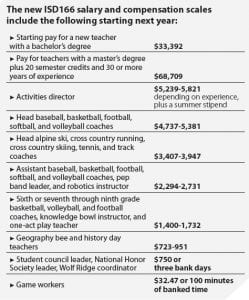The ISD 166 School Board has finished its negotiations with the Cook County Educational Association—the teacher’s union— but it wasn’t an easy process. At the May 17, 2012 school board meeting, Terry Collins reported on his and board member Mary Sanders’ work negotiating on behalf of the board. Representing the Cook County Education Association (CCEA) were Al Heine, Marc Tavernier, and Betsy Jorgenson. The agreement, which applies to 39 teachers, will be in place for the years 2011-2013.
A mediator was hired because the two parties could not agree on salaries, Collins said, but the process took place “without any acrimony or distrust.” Collins said he believes the union reps acted in the best interest of the district, and he thanked them for their professionalism.
Arbitration was considered, Collins said. The union asked for a 3.1 percent increase. After Collins and Sanders were told that they would be likely to end up increasing salaries even after arbitration, he said, they decided to spend the $18,000-20,000 they would have spent on arbitration on salaries instead.
Theresultwasa0percentsalary increase this year (although teachers will still move up the pay scale based on years of experience and educational level) followed by changes in the salary scale next year—which together will amount to an increase of approximately 2 percent in the amount paid out in teaching salaries next year. Collins said, “We eliminated the bottom level of the pay scale.” They believed it was not competitive, he said.
Also increased was remuneration for coaching and other student involvement outside the regular classroom. According to Sanders, this raises compensation to more professional levels.
Collins indicated that the old pay schedules for things like coaching, advising student groups, and chaperoning weren’t necessarily fair and had become “cluttered with inconsistencies.” To determine pay, they came up with a mathematical formula that better reflects the actual work done, training required, financial accountability involved, and supervision needed for each activity. As a result, some jobs increased in pay and some decreased, but anyone currently doing a job will not get a reduction in pay, Collins said.
Retirements and resignations of current staff will save the district $135,000 next year.
“I hope that no board has to wrestle with this again for quite awhile,” Collins said.
“I think future boards will really appreciate this,” said Sanders.
The board unanimously approved the proposed agreement with the CCEA.
In other school news:
The problem of lice has been pestering Cook County families this year, and some parents want to know how it can be avoided. Schwarz’s monthly report to the board stated, “We have had an ongoing problem with lice, more so this year than in the past. Parents and employees are understandably quite frustrated.”
Superintendent Schwarz said she has been told the problem is “almost as common as the common cold.” She said she wants parents to know “we are listening to them.”
The Minnesota Department of Health now recommends allowing children to return to school the day following treatment; previously they recommended that children not return until they were nitfree.
When lice have been identified on a child, his or her classroom is cleaned and vacuumed and plush items are bagged in plastic.
A contract for $27,000 with the
Human Development Center was approved for a 3/4-time mental health caseworker. The other 25 percent of this worker’s time will be spent at Great Expectations Charter School.
Superintendent Schwarz received a
“report card” from the board reflecting their assessment of her performance from November to May.
The assessment addressed 10 areas, including such things as educational leadership, informing and advising the board, acting as a liaison to the community, overseeing finances, and updating plans and goals. Her marks ranged from “meeting expectations” to “outstanding performance,” with an average rating of “very good.” “High praise” was given for trust gained in community outreach. The report acknowledged growth in financial leadership but listed the Community Ed budget as an area for future growth. Also listed under areas for growth in educational leadership were industrial arts and curriculum planning.
Curriculum requests in the amount of $63,934 were approved from the music, visual art, health education, and physical education departments. The curriculum funding cycle is seven years.
Music/band teacher Kerry Bilben made a good case for expenditures of $30,504 in the music department. The elementary textbooks dated back to 1983 “and some of them smell funny,” Bilben said. They are also not multiculturally sensitive and not politically correct, she said.
Bilben also requested funding to replace some band instruments. “We have ugly trumpets, but they play great,” she said. On the other hand, the tuba is in terrible shape, she said. “I’m about to have a wake for it.” When they travel, she said, kids will ask if they have to bring the tuba, which is extremely dented. She will tell them, “Yes, because it’s the foundation of our band.” Some band instruments are held together with electrical tape.
“We should have a music/arts booster club!” Mary Sanders said.
Visual arts teacher Mary McDonald requested $18,600 for her program. Pam Taylor requested $6,030 for the health education department and $8,800 for the physical education department.
School board member Leonard Sobanja said, ‘“Our job is to make sure the kids and teachers have the tools they need to do the work they have to do.”



Loading Comments